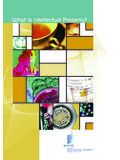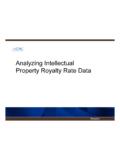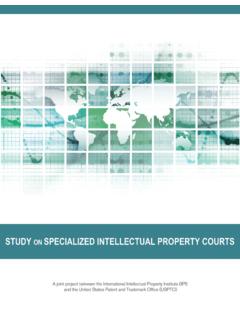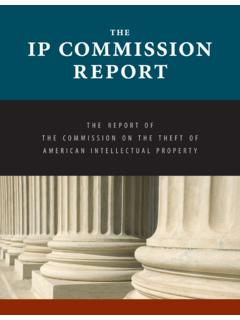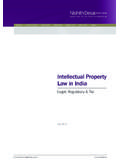Transcription of LECTURE 09 (Notes) COPYRIGHT AND …
1 DON MILLIGAN: 2004 1/21 LECTURE 09: INFORMATION & POLITICS SERIES COPYRIGHT and Intellectual Property Generally property is vested in a thing or in land. It is a thing that can be bought and sold, exchanged, traded, hired out. It has to have these physical properties. It can then be protected by common law and by statute. Its enjoyment can be guaranteed by custom. Constitutions and other legal instruments can guarantee the sanctity of such possessions. On the other hand, intellectual property, is intangible, it is not a thing. It cannot be held in the hand. Yet we know it as property because it can be bought and sold, exchanged, traded, hired out. Intellectual property has these commercial characteristics, but none of the physical attributes of ordinary, real or tangible property.
2 It is vital to grasp this distinction because a book, a blueprint, a sheet of music, or a CD is never literally the subject of intellectual property laws the particular book, the particular DON MILLIGAN: 2004 2/21 sheet of music, the particular CD, is not copyrighted. It is the specific arrangement of words or notes upon a page, which is copyrighted; it is the specific form of the music on the CD or the radio show, which is copyrighted. Of course, intellectual property is always attached to a physical thing; intellectual property is always carried by something with material qualities, but the intellectual property itself is not the physical thing, upon which, or in which, it is carried.
3 If you buy a book in a shop, if you buy a CD in a shop, once you have paid your money legal title to that particular object changes hands it becomes your book or your CD; your possession and the private enjoyment of it is protected by law and guaranteed by the state. However, you do not own the intellectual property contained within the book or the CD. The right to claim authorship, or the entirely separate right, to reproduce or copy the book or CD, is DON MILLIGAN: 2004 3/21 not yours in the shop you bought the tangible thing, not the intangible intellectual property. So the purchase of some writing or music or movies for your private enjoyment is sharply different from the purchase of the COPYRIGHT to that writing, music or film.
4 When somebody buys the COPYRIGHT they purchase the right to reproduce the specific arrangement of words or notes upon a page; they purchase the right to copy the particular arrangement of sounds or images upon a disc. However, they are not the outright owners of the intellectual property because of what the lawyers call moral right . The sale of the COPYRIGHT by an author to a publisher or a distributor does not undermine or abolish the author s moral right . Thus the author remains the author whether she has sold the COPYRIGHT to her novel or her research paper or not. She continues to have the right to be acknowledged as the author and is protected from the DON MILLIGAN: 2004 4/21 mutilation or alteration of her work by the publisher or distributor to whom she sold the COPYRIGHT .
5 So, the author always has moral rights in relation to his creations. His play, his textbook, his blueprints always remain his, even though he may have sold the right to copy and distribute his work to another person or company. This LECTURE is, by moral right , my intellectual property. I wrote it, I have the right to be identified as its author, and I am protected from it being altered in any way by another person. However, I do not own the COPYRIGHT . The COPYRIGHT belongs to Manchester Metropolitan University because it is part of my contractual responsibilities, for which I am paid, to write Similarly, if a stock exchange or any other institution awards or sells the rights to distribute or disseminate information which it 1 See Jeremy Phillips, et.
6 Al., Whale on COPYRIGHT , London: Sweet & Maxwell, 1997, DON MILLIGAN: 2004 5/21 has gathered together, to a news agency or information bureau, then the right to distribute the news about that information stock or commodity prices for example belongs to They have paid the authors or source of the information for the privilege of spreading the news. By payment they have changed legal title to this knowledge as if the knowledge was a thing. So, intellectual property has this threefold aspect: 1. The moral right of the author to protect the arrangement or form of his work and to be identified as its creator. 2. The commercial right of the COPYRIGHT -holder to reproduce and distribute the work.
7 3. The right of those who have paid the COPYRIGHT -holder for permission to enjoy the work in private, or the special right of those who have paid for permission use the work in public performances. It is from these three aspects that we can see the peculiar character of intellectual property and the ways in which it is a specific kind of property quite different from the property in 2 See J. W. Harris, Property & Justice, Oxford: Oxford University Press, 1996, DON MILLIGAN: 2004 6/21 things that we more easily identify as property belonging to a particular person or institution. Intellectual property exists in the form of (1) patents, (2) COPYRIGHT , and (3) trademarks and industrial designs.
8 These three different sorts of intellectual property are the subject of different legal provisions, but my focus is going to remain on COPYRIGHT as the most common or widespread form of intellectual property and the one in which we are most likely to encounter the law and the conflicts to which it gives rise. It is often difficult to believe that the COPYRIGHT should be respected. It can, at times, appear to be at best, unjust, and at worst, simply insupportable. In this respect, our difficulties are revealed very clearly by the Universal Declaration of Human Rights adopted by the United Nations in 1948. Article 27: reads: DON MILLIGAN: 2004 7/21 (1) Everyone has the right freely to participate in the cultural life of the community, to enjoy the arts and to share in scientific advancement and its benefits.
9 (2) Everyone has the right to the protection of the moral and material interests resulting form any scientific, literary or artistic production of which he is the Now, clearly there is a conflict between these two rights: (1) the rights of the person or citizen to access cultural production of all sorts, and (2) the rights of the authors of that cultural production to benefit materially from their creative work. When teachers at MMU distribute photocopies of chapters taken from books they are providing access to work that you would not otherwise be able to read, or at least, not get hold of very easily. In doing so, they are I hope careful, always to include the title page of the book and the page bearing the book s publication details.
10 They do this for two reasons: (1) to make it 3 Universal Declaration of Human Right, Adopted and proclaimed by General Assembly resolution 217 A (III) of 10 December 1948, quoted from the website last visited on 18/02/04. DON MILLIGAN: 2004 8/21 easier for you to find the book should you want to read more of it, and (2) to support the moral right of the author to recognition for having written the book. In doing so, strictly speaking, they are breaching the publishers and the author s COPYRIGHT . However, except in the case of popular textbooks or manuals they could not be said to be damaging the sales of the author or publisher by handing out photocopies taken from very expensive, hardback, academic works.
